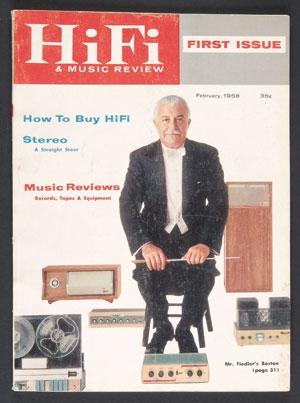50 Greatest A/V Innovations

| Click here to see a gallery of innovative products. |
It's 5 decades ago, and you're one of the first guys to pick up a copy of HiFi & Music Review. What's in your system? Although you're far more likely than the average American to have a stereo setup, chances are you're still listening to mono, if only for another year or two. So you have one speaker, which could be anything from a big corner Klipschorn to one of those newfangled compact acoustic-suspension designs from Acoustic Research or KLH. Maybe you have a receiver, but probably you have a separate preamplifier, power amplifier, and FM tuner. And unless you're really avant garde, they're all built with vacuum tubes. If the amp can give you an honest 15 watts, you're pushing some serious power.
Besides FM, you listen to LP records, which stores are just beginning to stock in two bins: mono and stereo. Maybe you have an open-reel tape deck, mostly for recording broadcasts - and if you're handy, you might have built some custom cabinets to house your gear in style. You probably have a TV in the room, though almost certainly not connected to your audio system. (GUI? Not in my house, buddy.) Even if you have an unusually elaborate stereo rig, you have no more than about a dozen signal-carrying cables to keep straight; more likely, it's only about a third that many. And of course, you have no inkling whatsoever of how profoundly your hobby is going to be transformed over the next few decades. After all, the only digital processor you've ever heard of is UNIVAC.
So much has happened since Sound & Vision's strictly audio progenitor first hit the stands that the biggest problem in putting this story together was deciding what to leave out. Herewith, our distillation of the top 50 audio and video innovations of the last 50 years.
1. Digital Recording In 1976, Dr. Thomas Stockham of the University of Utah made the first commercial digital audio recording. He had founded Soundstream (no relation to the current company of the same name) to design and build the necessary hardware, which captured 16-bit audio at a 50-kHz sampling rate. For years, his and other digital recordings were funneled through analog media for release, but the technology opened the door for almost every other major development in audio since, from the CD to the iPod, and many in video as well.
2. Apple iPod The digital revolution's ultimate fruits were unanticipated in 1976, much less in 1958: instant availability of your entire music collection from a pocket-size, battery-powered device, and the ability to buy that music without visiting a physical store or handling any physical media. Apple's introduction of the first iPod in 2001, in conjunction with iTunes, crystallized those potentialities with such near-perfection as to frustrate all would-be competitors ever since. Encore? Add video and stir. (Click here to see a gallery of this and other innovative products.)
3. CD The format that changed everything, forever. As good as it was, the LP record was always a filter - a layer that subtracted from and added to the original sound, theretofore heard only by the artists, engineers, and producers in the studio. Launched in 1982, the Compact Disc (CD) hot-wired the world to the control room. But astonishing clarity (and durability) weren't CD's only virtues: It was also unbelievably convenient. No more turning the record over to hear the rest of the music, no more fussy mechanical adjustments - and portable and car players were suddenly very practical.
- Log in or register to post comments























































